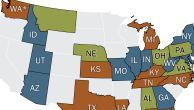Latinos in the U.S. labor force were slow to recover from the effects of the 2001 recession, lagging non-Hispanic whites in restoring employment growth and the unemployment rate to their pre-recession levels. Immigrants and young Latinos encountered particularly hard times but college-educated Hispanics experienced substantial improvements in employment levels. These are among the key findings of this report on the labor market experience of Latino workers since the economic slowdown began at the end of 2000. The report examines a variety of trends in employment, unemployment and wage rates for both Hispanics and non-Hispanics from the end of 2000 to the end of 2002 and it also explores outcomes by industry, occupation, geographic region, age, nativity and education.
A key characteristic of the Latino labor force is that it continued to grow in size through the recession and the aftermath due to immigration and the steady flow of native-born youth reaching working age. Meanwhile, population and labor force growth among non-Hispanic whites and blacks were at a virtual standstill. Employment growth slowed for all groups but the demographic trends were powerful enough to produce increases in the number of employed Latinos even while the number of employed non-Hispanics declined. The report, however, estimates that Hispanic employment is more than 500,000 workers below its potential level because of the effects of the slowdown, a shortfall equivalent to 3.5 percent of the Latino workforce. Non-Hispanic employment is estimated at 3 million workers below its potential, a gap equivalent of 2.5 percent of employment.
As employment growth slowed, Hispanic, white and black workers were buffeted by the same structural forces and gained and lost jobs largely in the same industries and occupations. There are some industries and occupations in which Hispanics gained jobs while other racial/ethnic groups lost jobs, but the reverse is true in some other industries and occupations. Moreover, gains for one group of workers did not always take place in the same geographic region as the losses for another group. For example, employment in construction, and business and auto repair services for Hispanics went up principally in the West, while whites and blacks lost employment in these industries mostly in the Midwest.
Employment growth for non-Hispanic whites had returned to its pre-recession level by the end of 2002, but the growth rates for both Hispanics and blacks had failed to rebound. The economic slowdown decreased the rate of growth in real wages for all groups of workers. The rate of growth in real wages was somewhat lower for Hispanics than for whites and considerably lower for blacks.




